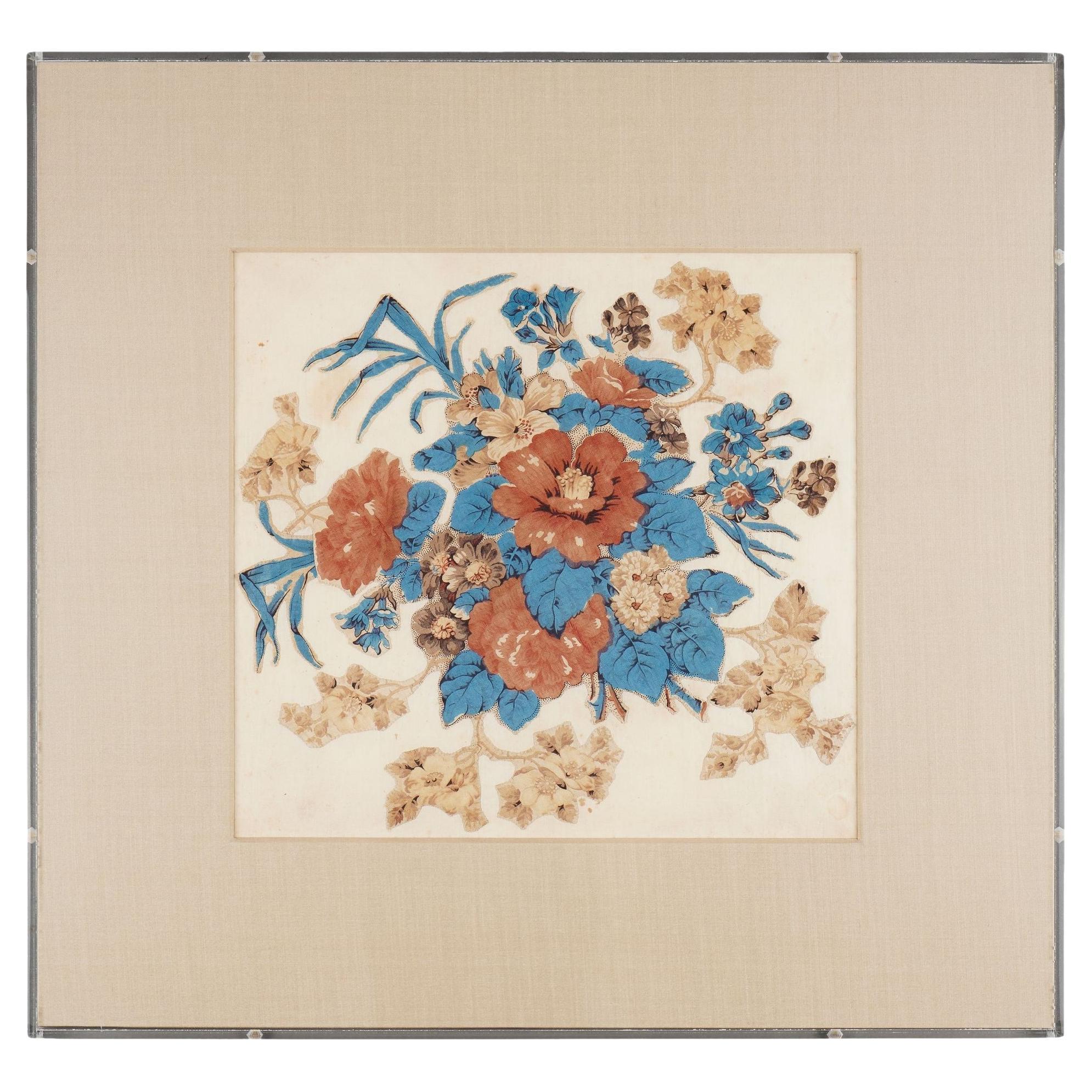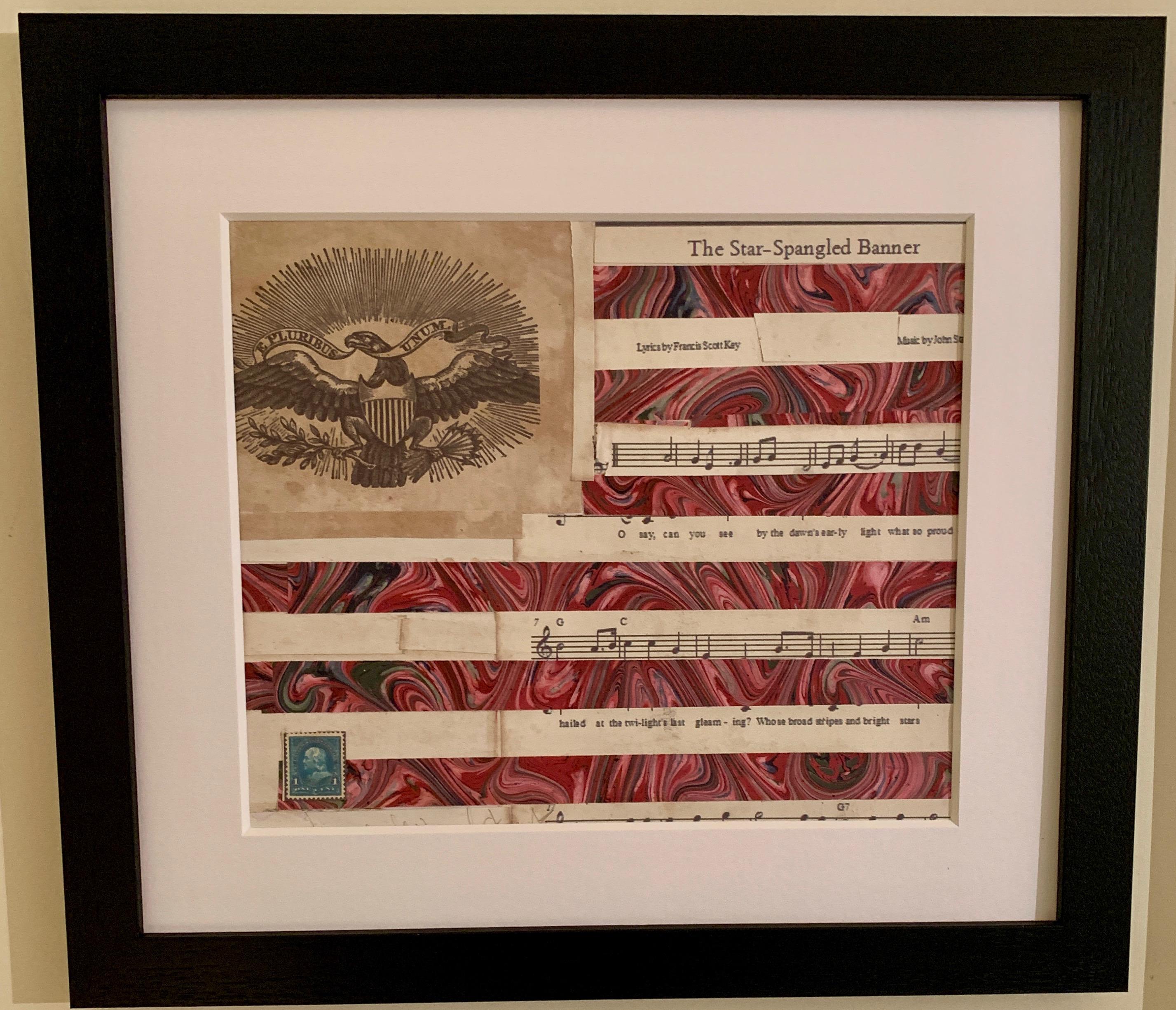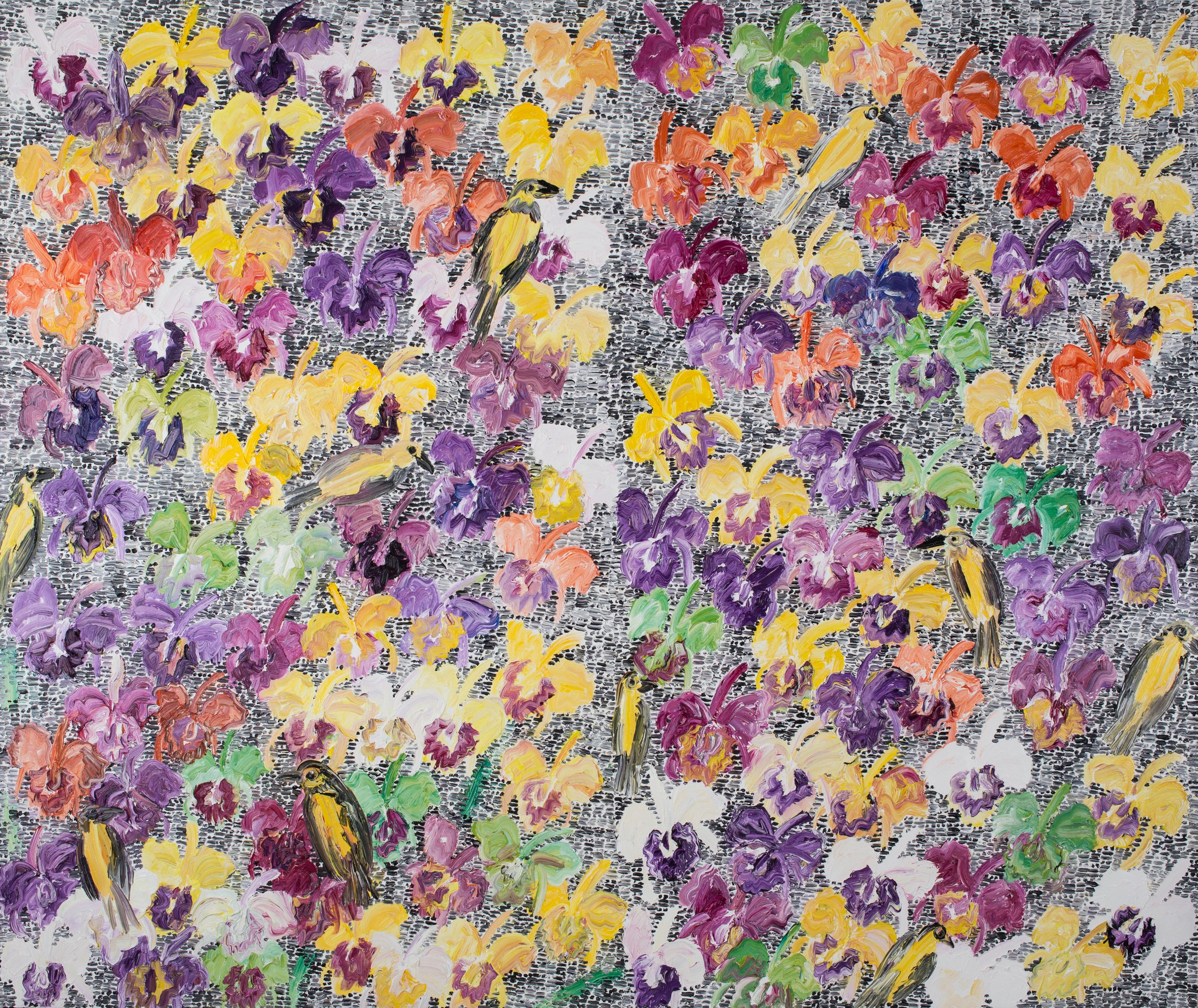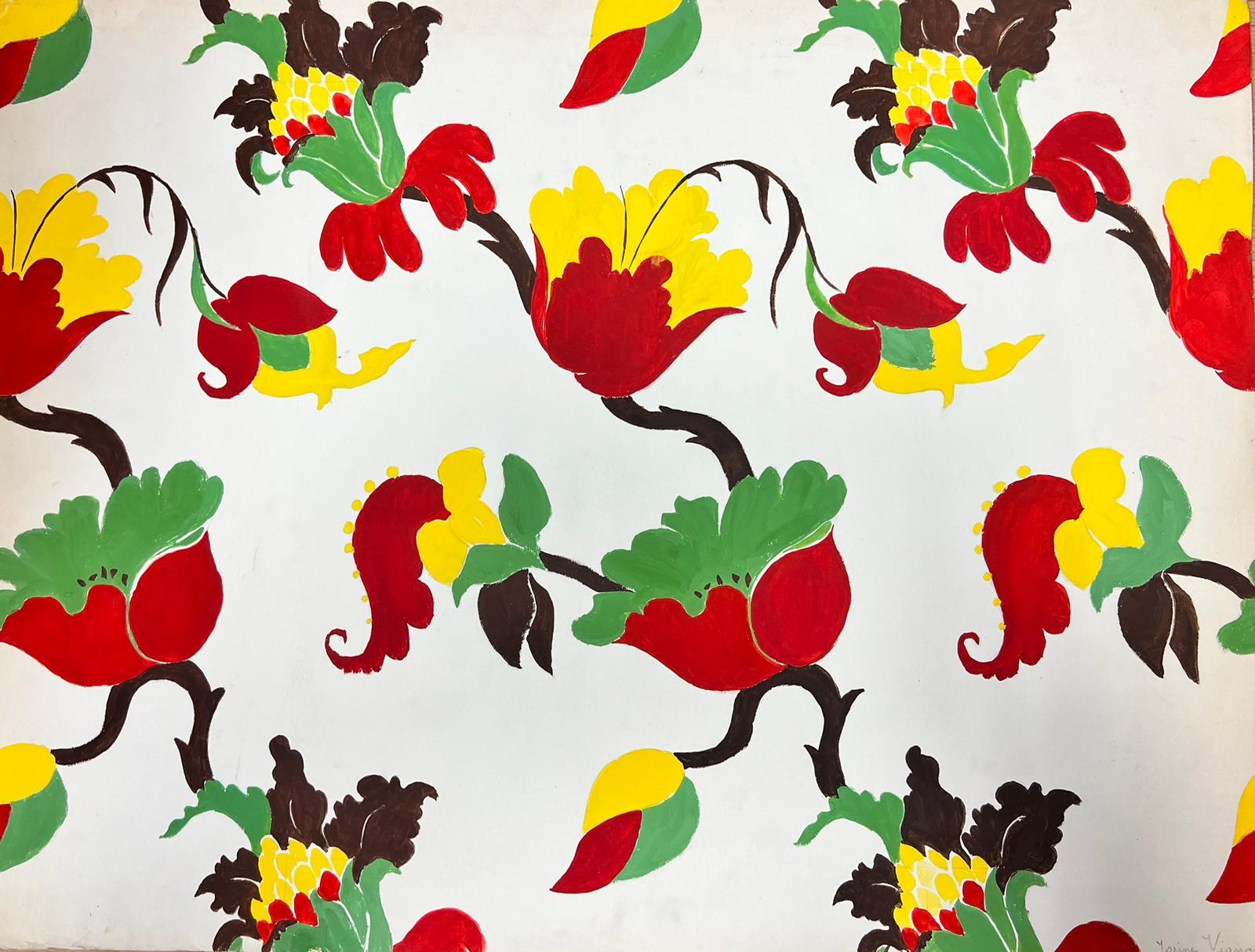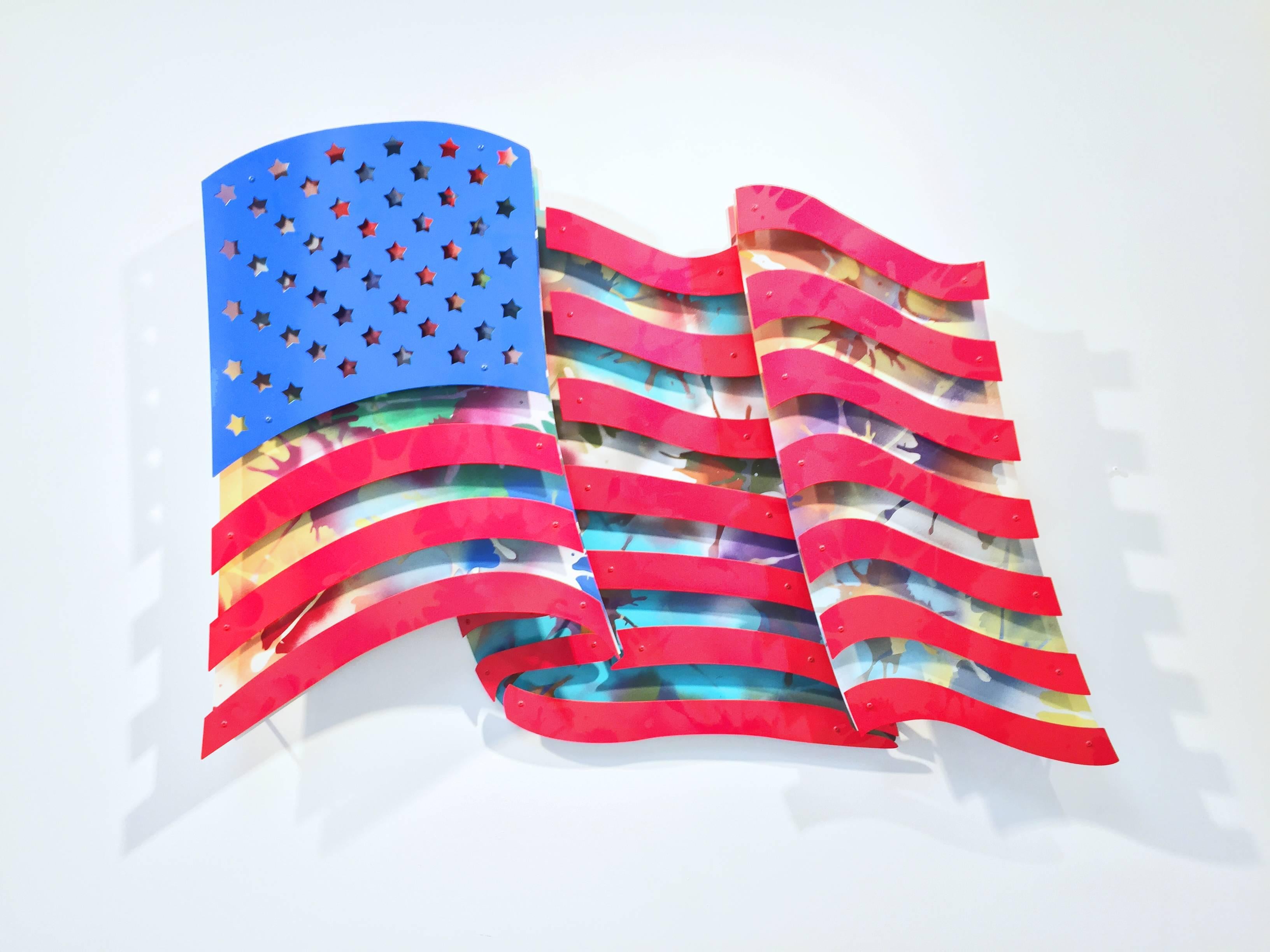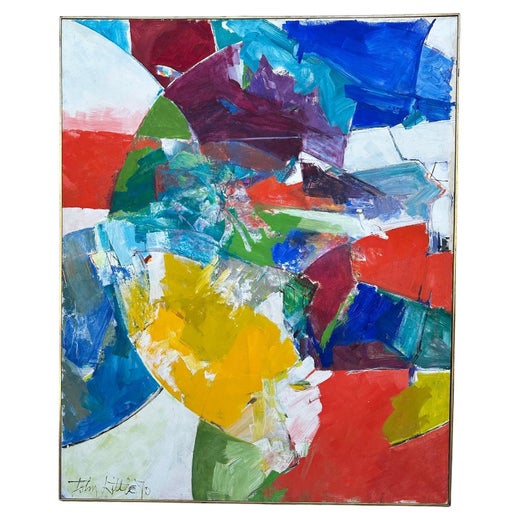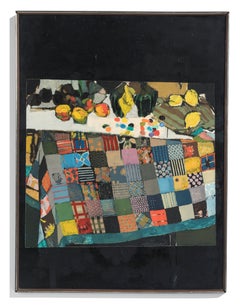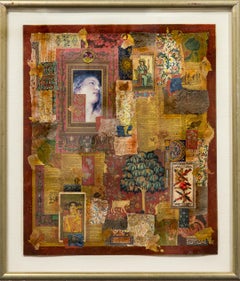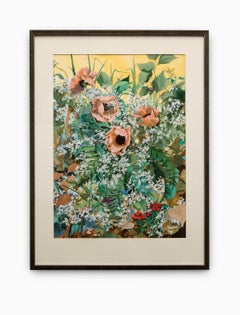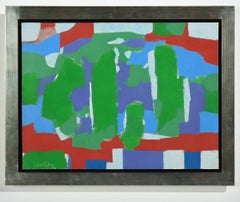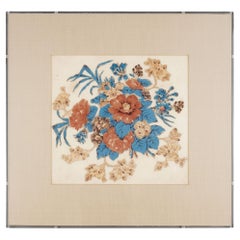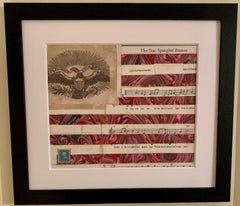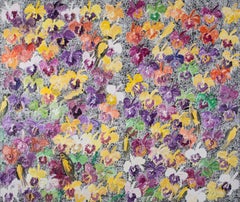Items Similar to John Little "Wallpaper Studies" Eagles, Flowers, Bunting, Color Code Bar
Want more images or videos?
Request additional images or videos from the seller
1 of 6
John LittleJohn Little "Wallpaper Studies" Eagles, Flowers, Bunting, Color Code Bar1935
1935
$3,555
£2,693.59
€3,090.68
CA$5,002.46
A$5,499.08
CHF 2,890.06
MX$66,778.84
NOK 36,052.81
SEK 34,157.51
DKK 23,066.51
About the Item
"Wallpaper Studies" is just that, a watercolor of a proposed design for a wallpaper with its's color code on the lower left. The painting is of a Nationalistic decorative theme with eagles, flowers, and red and white bunting all displayed on a brilliantly blue background. It might be hard to imagine now in the 21st century a room covered in such a dynamic and colorful a design, but framed as a painting, it succeeds as a bright splash of color with a reminder of important iconic Nationalistic themes.
John Little was an abstract expressionist artist who founded a New York company that made fabrics and wallpaper with designs inspired by abstract expressionism.
His work was shown in galleries in Europe, Japan and the United States. Among his larger one-man shows was an exhibition of paintings at the California Palace of the Legion of Honor in San Francisco in 1946; of paintings and collages at the Worth Ryder Gallery at the University of California at Berkeley in 1963, and a selection of his 70's works at the Fine Arts Center of SUNY at Stonybrook, N.Y., in 1981. A retrospective of his work was shown at the Guild Hall Museum in East Hampton in 1982.
John Little was born in Alabama and as a teenager attended the Buffalo Fine Arts Academy now known as the Albert Knox Art Gallery founded in 1862 and one of the oldest art galleries in the United States. Their collections are modern pieces showing styles of abstract expressionism, pop art, and art of the 1970s through the end of the century. The Knox gallery also represented such artists such as Arshile Gorky, Jackson Pollock, Clyfford Still, and Andy Warhol. Additionally, the gallery was also rich in various pieces of post-war American and European art. Their contemporary collection includes pieces by artists such as Kiki Smith, Allan Graham, Georg Baselitz, John Connell, and Per Kirkeby, the Danish painter.
Little attended the Art Student League and studied under George Grosz, painting mainly Cezannesque landscapes. From 1937 to 1942, he started working with Hans Hofmann in both New York and Provincetown, which pushed him towards abstraction and his first serious involvement as a painter. At Hofmann’s school he met artists such as Lee Krasner, George McNeil, Gerome Kamrowski, Giorgio Cavallon and Perle Fine.
In 1942 he became a naval serial photographer returning to New York after the war and moved into Hans Hofmann’s 8th Street studio where his neighbors were Lee Krasner and Jackson Pollock. The paintings of the late 1940s reveal great experimentation and a growing interest in both Surrealist automatism, Picasso and the theories of Hans Hofmann. In 1946 he had a one-man show at the California Palance of the Legion of Honor in San Francsico with a follow-up solo show at Betty Parsons. It was at this time that Little and Pollack had two main shows together that were exhibited across the U.S.
He began painting in the 1950s in thick, gestural buildup of paint and started a series of constructions created from driftwood and beach-coming detritus. Little and Pollock had a joint exhibition in 1955 at Guild Hall. He helped found the Signa Gallery, an important outpost in East Hampton for the growing New York art scene. Little had solo exhibitions at, among others, Betty Parsons Gallery, Bertha Schaefer Gallery, Worth Ryder Gallery, A.M. Sachs Gallery, and the Guild Hall Museum. His work is part of the permanent collections at The Metropolitan Museum of Art, The Guild Hall Museum, Ball State University Museum of Art and Galerie Beyeler among others.
Unframed the piece measures 32” h x 50” w.
- Creator:John Little (1907-1984, American)
- Creation Year:1935
- Dimensions:Height: 34.5 in (87.63 cm)Width: 53 in (134.62 cm)
- Medium:
- Movement & Style:
- Period:
- Condition:
- Gallery Location:Detroit, MI
- Reference Number:1stDibs: LU128616084372
John Little
Born in Alabama, John Little attended the Buffalo (NY) Fine Arts Academy as a teenager, until 1927. Soon after, he moved to New York where he began operatic vocal training and opened what would become a very successful textile business designing fabric and wallpaper. In 1933, he enrolled at the Art Students League under the tutelage of George Grosz. Little’s early work consisted predominantly of landscapes, until 1937, when he began studying under Hans Hofmann and his work naturally shifted toward abstraction. During his time with Hofmann, he with artists such as Lee Krasner, George McNeil, Gerome Kamrowski, Giorgio Cavallon, and Perle Fine. Little entered the the service in 1942 as an aerial photographer for the Navy. Returning to New York after the war and with nowhere to stay, he reconnected with Hofmann and moved into his 8th Street studio, alongside his friend Lee Krasner and her husband Jackson Pollock. In 1946, Little earned his first solo exhibition at the California Palace of the Legion of Honor in San Francisco, with a subsequent solo exhibition at Betty Parsons Gallery in New York two years later. In the early 1950s, Little abandoned the flat, linear style in favor of a new aesthetic consisting of the thick, gestural buildup of paint. This stylistic change was concurrent with his move to East Hampton In 1951. This enabled him to continue a close friendship with Krasner and Pollock, who had already left the city in favor of the more rural area around East Hampton. Little and Pollock had a joint exhibition in 1955 at Guild Hall, one year before Pollock’s tragic death. John Little exhibited extensively during his career, with solo shows at Betty Parsons Gallery (1948), Bertha Schaefer Gallery (1957, 1958), Worth Ryder Gallery (1963), A.M. Sachs Gallery (1971), and a retrospective at the Guild Hall Museum (1982). His work can be found in many private, institutional, and corporate collections around the world, including the Metropolitan Museum of Art, Guild Hall Museum, Ball State University Museum of Art, and Galerie Beyeler.
About the Seller
5.0
Vetted Professional Seller
Every seller passes strict standards for authenticity and reliability
Established in 2014
1stDibs seller since 2019
108 sales on 1stDibs
Typical response time: 17 hours
- ShippingRetrieving quote...Shipping from: Detroit, MI
- Return Policy
Authenticity Guarantee
In the unlikely event there’s an issue with an item’s authenticity, contact us within 1 year for a full refund. DetailsMoney-Back Guarantee
If your item is not as described, is damaged in transit, or does not arrive, contact us within 7 days for a full refund. Details24-Hour Cancellation
You have a 24-hour grace period in which to reconsider your purchase, with no questions asked.Vetted Professional Sellers
Our world-class sellers must adhere to strict standards for service and quality, maintaining the integrity of our listings.Price-Match Guarantee
If you find that a seller listed the same item for a lower price elsewhere, we’ll match it.Trusted Global Delivery
Our best-in-class carrier network provides specialized shipping options worldwide, including custom delivery.More From This Seller
View AllCharles McGee Oil Painting "Squares and Things" African-American 1967
By Charles McGee
Located in Detroit, MI
"Squares and Things" painted by the eminent artist, Charles McGee, literally breaths his African American heritage and his extraordinary vibrant use of colors. Provenance is The Arwin Galleries on Grand River in Detroit, Michigan - label on verso.
This early painting of McGee's shows his mastery in creating a painting in the style of the French Impressionist Edouard Manet, "Still Life with Melon and Peaches" located in the National Gallery of Art, Washington, DC, and in the style of Fauvist/Expressionist painter Henry Matisse, "Still Life with Blue Tablecloth", located in the Hermitage Museum, Saint Petersburg, Russia. McGee makes the well-known genre of still life his own creating an exciting marvelous work incorporating the homely quilt - the powerful symbol of the African American road to safety from slavery - as his main focus. Quilts symbolize warmth, comfort, and as shown by the collection of quilts gathered by the artists in Gee's Bend the designs on the quilts hung outdoors at locations along the Underground Railroad showed fugitives the road north and to safety. "Squares and Things" was first shown at The Arwin Galleries, Inc., Detroit, Michigan, one of the stops along the Underground Railroad.
This piece is signed by the artist, Charles McGee, and is an extraordinary example of his early work before he moved into Abstract Expressionism and his many sculptural works now located throughout Michigan. Several of these works are: "Noah's Ark: Genesis, 1984," on display at the Detroit Institute of Arts, his brilliant 2005 "Progression" a 45-foot wide aluminum sculpture at Beaumont Hospital, Royal Oak, Michigan, and his stunning 2016 "United We Stand" sculpture at the Charles H. Wright Museum of African American History . His genius can be seen in sculpture installments throughout the city of Detroit. .
He was born into a family of sharecroppers. While helping his grandfather tend the land, "he observed firsthand the order and harmony that exists within nature." He had no formal schooling until moving to Detroit at age 10, where he found that "everything was on the move and it hasn’t slowed down yet." in 2017 he observed, "I learned something not being in school — because life is school . . .I learn something every time I move. Every time I go around a corner, something new is revealed to me.”
McGee took advantage of the GI Bill to attend classes at the Society of Arts and Crafts, now the College for Creative Studies, Detroit, MI. Other College for Creative Studies (formerly Center for Creative Studies) faculty and graduates include Richard Jerzy, Harry Bertoia, Doug Chaing (currently director of Lucas Film), Stephen Dinehart (game maker, writer, designer connected with The David Lynch Foundation), Tyree Guyton (international artist), Herb Babcock, Jerome Feretti, Kevin Siembieda (writer, designer and publisher of role-playing games), Renee Radell, and Philip Pearlstein.
After retiring from the Corps of Engineers, McGee spent 1968 studying art in Barcelona. Despite not knowing the language at the outset, he immersed himself in the culture and opened himself to a whole new range of experience that would play out in his artwork. "If you free yourself, you have this kind of opportunity to have those experiences, horizons, and new vistas." (per interview with Nick Sousanis author of a book on Charles McGee.)
He returned to Detroit and curated "Seven Black Artists" at the Detroit Artists Market in 1969, which along with McGee himself, included Lester Johnson, Henri Umbaji King, Robert Murray, James Lee, Allie McGhee...
Category
Late 20th Century American Modern Still-life Paintings
Materials
Masonite, Oil
Melanie Boone "Untitled Collage", Mixed Media Collage
Located in Detroit, MI
This mixed media collage by Melanie Boone is a delightful and strikingly layered composition that evokes the wonder of a medieval tapestry or a troubador...
Category
Late 20th Century Mixed Media
Materials
Mixed Media
Stephanie Henderson Floral Garden Watercolor
By Stephanie Henderson
Located in Detroit, MI
SALE ONE WEEK ONLY
This is an untitled still-life watercolor of a floral garden with poppy's, baby breaths and euphorbia by Stephanie Henderson née ...
Category
1980s Naturalistic Still-life Paintings
Materials
Paper, Watercolor
Carl Holty Abstract Oil Painting "Riviera" in Primary Colors
By Carl Robert Holty
Located in Detroit, MI
"Riviera" is an exquisite painting of American Modern - primary colors actively composed in energetic movement and structure on the painted surface. These colors formulate the painting, play both for and against each other and create a lively surface with hints of either an architectural structure or freeway. This painting hints to future Modernists such as Richard Diebenkorn "Driveway" and David Hockney "Garrowby." Unframed the piece measures 18 x 24.
"Riviera" is signed on lower left. On verso is Provenance of over 70 years, 3 galleries in New York and one in Detroit, Michigan: Andrew Crispo Gallery, Sid Deutsch Gallery and Linda Hyman Gallery in New York and Collected Detroit Gallery in Detroit, Michigan.
Abstractionist Carl Robert Holty was known for his biomorphic abstract forms as well as the geometric abstractions he painted with his vibrant color palette. Born in Frieburg, Germany his family immigrated to the United States settling in Wisconsin. In 1919, he enrolled at the Art Institute of Chicago, and shortly thereafter attended the Parsons School of Design. He spent a short time at the National Academy of Design and studied with Francis Coates Jones...
Category
Mid-20th Century American Modern Abstract Paintings
Materials
Oil, Canvas
"Grid No.8", Discontinuous Storyboard Acrylic, Watercolor, and Pastel on Canvas
Located in Detroit, MI
SALE ONE WEEK ONLY
"Grid No.8" is a multi-material canvas work that is part of his series on creating discontinuous storyboards that reflect the the way an innocent mind is forced to process the confusing, muddled, and discordant images of media and society. The piece was painted in acrylic, watercolor, and pastel on canvas and is 78 in by 90 in.
Sun Wang is from Chengdu, China. He is currently based in Detroit, Michigan after receiving his M.F.A from Cranbrook Academy of Art in 2019. He is currently in a residency at Carrie Able Gallery in Williamsburg, New York. He was chosen as one of the 10 Artist Fellows for Playground Detroit...
Category
2010s Figurative Paintings
Materials
Canvas, Pastel, Acrylic, Watercolor
"Untitled Abstract" Abstract Expressionist, Color Field, Black & White, Colors
By Robert Goodnough, 1917-2010
Located in Detroit, MI
"Untitled Abstract" is by the American painter, Robert Goodnough, known for calligraphy-like markings circa 1960s. Though he was associated with the Abstract Expressionists, Goodnoug...
Category
1960s Abstract Expressionist Abstract Paintings
Materials
Canvas, Oil
You May Also Like
American floral chintz appliqué quilt square, 1825-50
Located in Kenilworth, IL
Floral bouquet chintz appliqué quilt square in red, blue, tan, and brown. Framed with a silk mat in UV filtering plexiglass box frame.
American, circa 18...
Category
Antique Mid-19th Century American Decorative Art
Materials
Cotton, Silk
American flag collage with a 19th century engraving of an eagle
By Claude Howard Stuart
Located in Woodbury, CT
Claude Howard Stuart is an artist working in Europe and America.
Watercolor, ink ,acrylic and and even cold wax and oil are the many different mediums that Claude uses on his varied and exciting works.
His influences come from all the different places and experiences he has had throughout his life, as well as the varied different art styles he’s studied.
Having lived in many different places around the world the styles of art, architecture, traditions and religions have all played into the art he makes..
He studies a period of art and then works with antique, vintage and original pieces to build his collage pictures making each one a unique study of a period, city or style.
Claude works on his pieces to bring together a feeling of the period and art movement that is inspiring him.
Sometimes Matisse and Picasso and other times old master drawings and abstracts.
These set of collage...
Category
2010s American Modern Mixed Media
Materials
Mixed Media
$1,510 Sale Price
20% Off
Free Shipping
American Flag with Arrows
By Paul von Ringelheim
Located in Long Island City, NY
An oil painting by Paul von Ringelheim. An abstract representational painting of the American flag.
Artist: Paul von Ringelheim, Austrian/American (1933 - 2003)
Title: American Flag...
Category
1960s Pop Art Abstract Paintings
Materials
Canvas, Oil
Hunt Slonem "Catalayas and Orioles" Birds, Flowers and Guardians on White
By Hunt Slonem
Located in Houston, TX
Hunt Slonem "Catalayas and Orioles" Birds, Flowers and Guardians on White
Multiple birds and orchid flowers on a white "Guardian" background
Unframed
Hunt Slonem is a well-renowned ...
Category
21st Century and Contemporary Neo-Expressionist Abstract Paintings
Materials
Canvas, Oil
Mid Century French Illustration Of Colourful Flower Wallpaper Sketch
By Josine Vignon
Located in Cirencester, Gloucestershire
Wallpaper Sketch
by Josine Vignon (French 1922-2022)
pastel/watercolor paper, unframed
painting: 19 x 25 inches
good condition
provenance: from the...
Category
Mid-20th Century Post-Impressionist Interior Drawings and Watercolors
Materials
Oil Pastel, Watercolor
American Flag - Multi Color
By Michael Kalish
Located in Los Angeles, CA
"American Flag - Multi Color" — enamel on layered laser cut aluminum — 33 x 48 x 4.5 inches. Edition of 35.
THIS IS A COMMISSION-ONLY PIECE THAT IS MADE UPON REQUEST. PLEASE ALLOW ...
Category
2010s Pop Art Abstract Paintings
Materials
Enamel, Metal
Price Upon Request
More Ways To Browse
Vintage Wallpaper
Midcentury European Street Scene Painting
Art Painting Flowers Purple
Paintings Of Palaces
Danish Mid Century Abstract Paintings
Driftwood Artwork
Vintage Bunting
Landscape Painting By W Hampton
Galerie Beyeler
Giorgio Cavallon
Graham Smith
London Landscape Painting
Seascape Original Oil Painting
St Louis Impressionist Paintings St Louis
Expressionist Oil Still Life
Italian Oil Paintings Of Naples
New York City Landscapes
Freedom Painting
